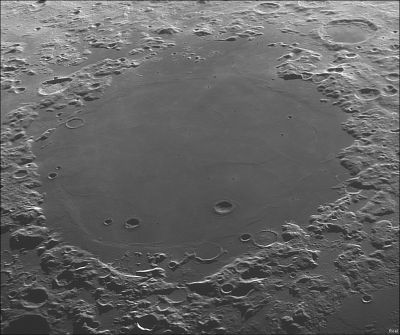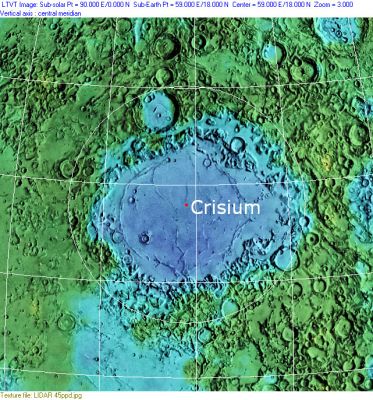Mare Crisium
Contents
- 1 Crisium Basin
- 1.1 Images
- 1.2 Maps
- 1.3 Basin Classification
- 1.4 Description: Wikipedia
- 1.5 Named lunar formations on the floor of Mare Crisium
- 1.6 Additional Information
- 1.7 Cloud at Mare Crisium?
- 1.8 More clouds?
- 1.9 Flashing Lunar Mountain at Mare Crisium?
- 1.10 Lunar Ellipse of Fire
- 1.11 Nomenclature
- 1.12 Greek letter designations at and near Mare Crisium
- 1.13 LROC Articles
- 1.14 LPOD Articles
- 1.15 Lunar 100
- 1.16 Bibliography
Crisium Basin
(unofficial name; IAU feature name for central 418 km of mare: Mare Crisium )
|
Lat: 17.0°N, Long: 59.1°E, Main ring diam: 740 km, Basin depth: 4.57 km, Rükl: 27 | |
Right: Clementine, Clementine LIDAR Altimeter texture from PDS Map-a-Planet remapped to north-up aerial view by LTVT. The dot is the center position and the white circle the main ring position from Chuck Wood's Impact Basin Database. Grid spacing = 10 degrees.
Images
LPOD Photo Gallery Lunar Orbiter Images Apollo Images
- WARNING: Apollo 10's Hasselblad frames AS10-29-4244 and 4245 don't show Mare Crisium! They show raycrater Petit at the northwestern border of Mare Spumans.
- A rather strange look at Mare Crisium is Apollo 16's oblique northward looking Fairchild camera frame AS16-M-1362. In this frame, Mare Crisium is located a the centre of the curved horizon.
- Additional research orbital Apollo photography: Danny Caes
Maps
(LAC zone 44D3) LAC map Geologic map LTO map
IAU page: Mare Crisium
Basin Classification
(description of terms and most numeric basin data from Wood, C.A. (2004) Impact Basin Database)
| Certainty of Existence |
USGS Age |
Wilhelms Age Group |
Ring Diameters |
Mare Thickness |
Mascon |
| Certain |
Nectarian |
11 |
360, 540, 740, 1080, 1600 km |
1.9 km |
Yes, +95 mG gravity anomaly |
Description: Wikipedia
Named lunar formations on the floor of Mare Crisium
Barker's Quadrangle, Curtis, Dorsa Harker, Dorsa Tetyaev, Dorsum Oppel, Dorsum Termier, Eckert, Fahrenheit, Greaves, Lev, Lick, Mons Usov, Peirce, Picard, Swift, and Yerkes
Additional Information
- Depth data from Kurt Fisher database
- Pike, 1976: 3.75 km
- Cherrington, 1969: 4.38 km
- 12 transient lunar phenoma reported in Crisium; A.P.S. Crotts (2007).
- Mare area of 228,000 km^2 according to measurements by Jim Whitford-Stark.
- Magnetic field anomaly and nearby gravity anomaly. Milbury et al, 2008
- Measurements of North West edge (PDF) by George Tarsoudis. Selenology Today No 12 2009 p 17-21.
- Curious obscure-looking depression with dark rim, detected by Danny Caes on the right part of Apollo 17's orbital ITEK-panoramic frame AS17-P-2227. This could be of the same nature as the so-called Cinder Cone near Lassell D, once observed and photographed by CMP Ken Mattingly of Apollo 16.
- One of two basins with crustal thicknesses near zero km. The Crust of the Moon as Seen by Grail by Wieczorek et al (2013).
- Atypical exposure of olivine-rich material - from mantle? - surrounding this basin. Yamamoto et al (2010) Nat. Geosci. 3, 533.
Cloud at Mare Crisium?
- Last evening (May 19th) on observing the moon's slender crescent, about two days old, I was struck with a very peculiar appearance on the westerly side of Mare Crisium, just on, or immediately within, the dark of the 'terminator'. It seemed a curved feathery mist or cloud lying just over the edge of the 'Mare', and against the spur or range of mountains bounding the westerly side of the great valley. It seemed to be divided longitudinally by a faint dark line, and looked not unlike a feather. It must have been more than 100 miles long, by 40 or 50 miles wide. The definition was excellent, and I watched it for nearly an hour, showing it to several friends. In colour and appearance it was so strickingly different from the other illuminated parts, and so different from anything else I have ever seen on the moon, that I scarcely think it possible to be mistaken in its vapoury character.
- Source: W.R.Corliss's Mysterious Universe; a handbook of astronomical anomalies, page 237 (Jackson, J.G.; English Mechanic, 35:326, 1882)
More clouds?
- Now, at various times when studying the floor of Mare Crisium, I have noticed waves of light and shade, so that it was difficult at times to see objects with which I was perfectly familiar. Also clouds have passed over the object I have been viewing. These clouds have been seen by other observers, and are mentioned in Neison. That they belong to the moon there can be no doubt, and I gradually come to the conclusion that vapour of some kind still existed on the moon. I had my surmises verified on one particularly fine night (the best I ever had) when I plainly saw a well-defined cloud pass over the object I was copying.
- Source: W.R.Corliss's Mysterious Universe; a handbook of astronomical anomalies, page 236 (Hardy, Jas. D.; British Astronomical Association, Journal, 7:139-141, 1897)
Flashing Lunar Mountain at Mare Crisium?
- Mr. Robert M. Adams has called to our attention a curious lunar observation by Mr. Robert Miles of Woodland, California, an observation rather reminiscent of Mr. Brian Warner's article on pages 130-131 of our November-December 1955 issue. Mr. Miles says in part: "I noticed a flash of white light that caught my eye. At first I thought it could have been a lunar meteor. But it kept flashing on and off... The light was very bright but changed its color to a very bright blue, like an arch light. It was brighter than the sunlit portions that I was looking at". Sketches indicate that the object in question lay on the night side of the terminator and perhaps about 100 miles east of the gap in the mountains on the east boundary of the Mare Crisium. Mr. Miles found the duration of visibility of the flashing light to be from 3:00 to 4:30 U.T. on January 17, 1956. The colongitude was then 320°.5 to 321°.3. These colongitudes seem inconsistent with the sketches, and the editor suspects that the U.T. date was really January 16. It would be interesting to hear whether anyone else was observing this lunar area at this same time, or better still, was then photographing the moon.
- Source: W.R.Corliss's Mysterious Universe; a handbook of astronomical anomalies, page 227 (Anonymous, Strolling Astronomer, 10:20, 1956)
Lunar Ellipse of Fire
The western part of the rim of Mare Crisium is (or was?) number eleven in the list of 12 localities in the Lunar Ellipse of Fire (see article from Farouk El-Baz in Sky and Telescope - June 1973).
Nomenclature
- The IAU feature name is Latin for "Sea of Crises", the Latin name having been given by Riccioli (1651) ( Whitaker, p. 215). The impact basin is named after the mare.
- Labeled Brittannia in a pre-telescopic sketch map by William Gilbert (ca. 1600) ( Whitaker, p. 15).
- Referred to as the Caspian by Thomas Harriot (1610) in describing his pre-Galileo telescopic sketch map of the Moon, suggesting this was an established name at that time, possibly inspired by Plutarch's mention (ca. 100 AD) of the Caspian Sea as typifying a sort of feature that might exist on the Moon (Whitaker, pp. 6-7 and 17) (Galileo mentions the "ancient spots" but gives no indication of their having had names).
- Labeled Mare de Moura in Van Langren's manuscript map, modified to Mare de Moura sive Caspium in his published engraving (1645) (Whitaker, p. 192).
- Hevelius (1647) (judging from the reproduction of his map in Whitaker, p. 53), seems to have called this Mare Moetius, using the name Mare Caspium for the modern Mare Fecunditatis. Oddly, Whitaker mentions neither of these in his list of Hevelius' names (Appendix E, pp. 201-208).
- Mare Crisium is nicknamed the Fish (or Angelfish) by Charles Wood (see LPOD Fish Scales).
- The western rim of Mare Crisium was once called the Coxwell mountains, but the I.A.U. did not accept that name (research: "Coxwell mountains" by Danny Caes; see: Recently named Lunar Craters. by W. R. Birt, Esq.).
- An area on the southeastern floor of Mare Crisium was once known to British observers as "The Trapezium" or Barker's Quadrangle.
- The main rim of Mare Crisium was unofficially named the Wasatch mountains by Charles Wood.
- Southeast of Mare Crisium (near Condorcet, Auzout, Firmicus, and Apollonius) runs the unofficially named North Valley/ Vallis North; or Vermiform Valley. These unofficial names are included in the Hitchhiker's Guide to Rukl 38.
- Long before the arrival of all these unofficial names, Hevelius (Johann Hewelcke, 1611-1687) called Mare Crisium's northern rim Montes Alani, and the southwestern rim Montes Corax.
- At 22.69°N /54.45°E (in Hevelius' Montes Alani) is a very bright ray-craterlet, which is nicknamed Facula Alani or Alani's Bright Spot by Danny Caes. The ejecta around this craterlet are readily visible towards the left hand edge of Eric Roel's image shown above.
Greek letter designations at and near Mare Crisium
- Harold Hill called the southeastern corner of Mare Crisium Promontorium Auzout Delta, see Harold Hill's A Portfolio of Lunar Drawings, pages 26, 27 (SE corner of the Mare Crisium region).
- Mare Crisium Delta (peak or hill in the western part of Mare Crisium's rim, north-northwest of Yerkes E).
- Mare Crisium Rho (pronounced part of J.Hewelcke's Montes Alani, west of Facula Alani) (for Mare Crisium Delta and Rho, see Chart 33 in the Times Atlas of the Moon).
- None of the Greek letter designations at the coastline of Mare Crisium were included on SLC chart A3 (the northern part of Mare Crisium) and SLC chart A4 (the southern part of Mare Crisium). Was the eastern part of the moon's near side (at and around Mare Crisium) somehow "forgotten" terrain during the making of the SLC charts? (System of Lunar Craters, 1966).
- Andradae and Torii were two of Van Langren's disallowed names for certain parts of Mare Crisium (Andradae should have been Mare Crisium Omega, and Torii should have been Mare Crisium Tau). Source: Ewen A. Whitaker's Mapping and Naming the Moon.
LROC Articles
LPOD Articles
- Little Detective.
- No Crisis In Crisium
- Crisium Closeup
- A Flat Black Crisium
- Sunset on the Wasatch Mountains
- Rays, Rays Everywhere
- Fish Scales
Lunar 100
- L10: Mare contained in large circular basin.
Bibliography
- Apollo over the Moon; A View from Orbit, Chapter 3: The Terrae (Part 1), Figure 34.
- Hill, Harold. A Portfolio of Lunar Drawings, pages 26, 27 (the SE-corner of Mare Crisium).
- Wood, C.A. Feb. 2004. "Auzout: A Minor Crater and Some Big Ideas."
- Sky and Telescope Feb. 2004.
- Wood, C.A. Apr. 2007. "Mystery Maria."
- Sky and Telescope 113(4): 63-64.

